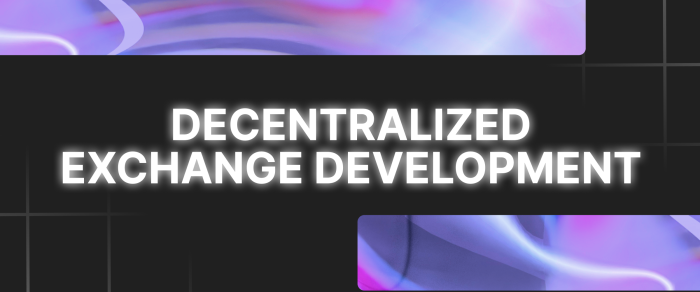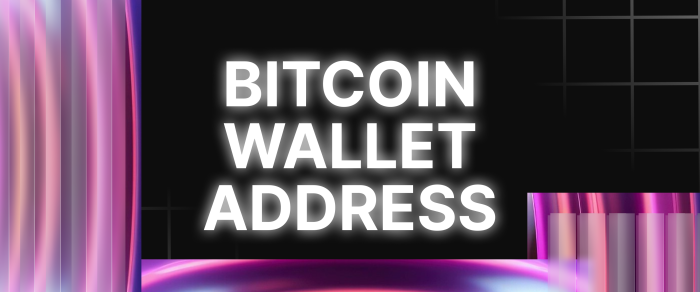Decentralized Exchange Development: A Guide to Building Your Own DEX
The digital asset industry is changing fast, and decentralized exchanges (DEXs) are taking center stage. In December 2024 alone, DEXs processed $320.5 billion in trading volume, setting a new all-time high and surpassing the previous record from just a month before.
At the same time, centralized exchanges (CEXs) are facing increasing security threats. Hacking-related losses in the crypto industry surged by 21% in 2024, reaching a total of $2.2 billion for the year. With every new security breach, more users are looking for safer, trustless alternatives—where they control their assets entirely.
So, how do you develop DEX from scratch? What features make a great decentralized exchange? And most importantly—how do you make it profitable?
Key Takeaways:
- Options for building a DEX include custom development, white-label solutions, or forking existing protocols.
- Successful DEX development requires smart contracts, liquidity management, and user-friendly design.
- Revenue streams include trading fees, token listings, governance tokens, and NFT launchpads.
- Key challenges include security risks, liquidity acquisition, scalability, and regulatory uncertainty.
What Is a Decentralized Exchange?
A decentralized exchange is a blockchain-powered venue where users can trade cryptocurrencies without ceding control of their funds to any central authority. Instead of relying on a single server or operator, these platforms leverage smart contracts on public networks such as Ethereum or BNB Chain to facilitate secure, peer-to-peer transactions.
At their core, DEXs offer:
- Peer-to-Peer Trading: Deals happen directly between individual participants, cutting out traditional middlemen.
- Smart Contracts: Automated code enforces trading logic—like order matching or liquidity pooling—right on the blockchain.
- User Custody: Traders control their private keys fully, which significantly reduces hacking risks compared with centralized exchanges.
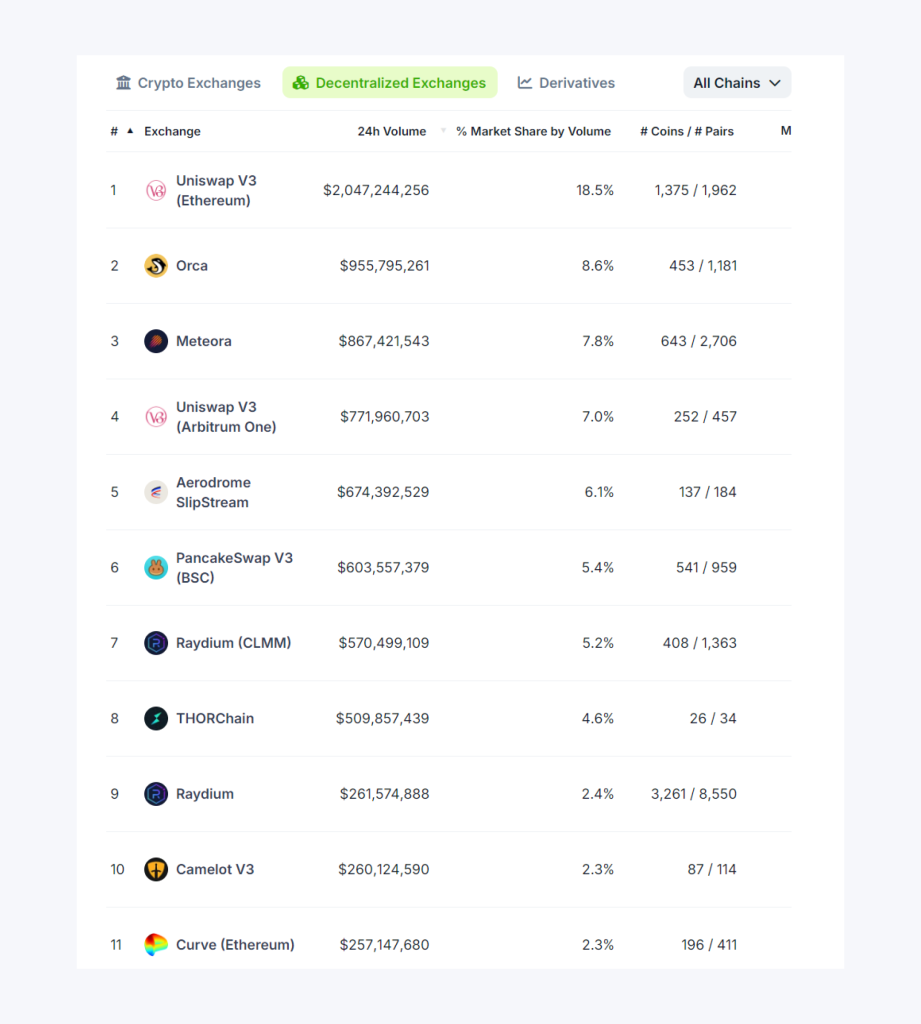
The concept of a decentralized exchange emerged alongside the rise of smart contract platforms. The earliest DEX attempts used on-chain order books—though they struggled with low liquidity—until the Automated Market Maker (AMM) model helped drive mainstream adoption.
Why Build a DEX?
The decentralized finance (DeFi) revolution is in full swing, and decentralized exchanges are at the forefront of this transformation. So, what makes building a DEX a compelling business move for today?
- Security & Trust: No Single Points of Failure
Centralized exchanges hold billions in user assets in hot wallets, making them prime targets for cyberattacks. And history has shown that even industry giants are not immune.
A notable example is the recent $1.5 billion theft from ByBit, the largest crypto heist to date. In contrast, DEXs operate on a non-custodial framework, allowing users to maintain control over their assets and significantly reducing the risk of such large-scale breaches.
- Regulatory Flexibility: The DeFi Legal Gray Area
Crypto regulation is tightening worldwide, with governments enforcing AML (Anti-Money Laundering) and KYC (Know Your Customer) rules on centralized exchanges. However, DEXs are decentralized, which makes it harder to regulate them, as these platforms do not custody assets, control trading, or process fiat transactions.
In 2023, Binance faced lawsuits from US regulators, forcing it to exit multiple jurisdictions and pay multi-billion-dollar settlements. Meanwhile, major DEXs have continued operations unimpeded, thanks to their smart contract-driven, permissionless design.
While regulatory frameworks around DEXs are evolving, their decentralized infrastructure often places them in a more flexible legal position compared to their centralized counterparts.
- Lower Operational Costs: No Overhead, Just Smart Contracts
Running a centralized exchange requires massive infrastructure, including:
- Data centers and servers for order matching
- Custodial security to prevent hacks
- Compliance teams to meet global regulations
- Customer support staff for user management
All of this translates into high operational costs—which are often passed on to users via trading fees.
- Community Governance: Users Shape the Future
Unlike centralized exchanges, which are run by corporations, many modern DEXs are governed by their communities. Governance tokens allow users to propose and vote on platform changes, ensuring decentralized decision-making.
In 2020, Uniswap launched UNI, a governance token that gives holders the power to vote on protocol upgrades, fee structures, and liquidity incentives. Since then, many liquidity incentives and protocol adjustments have been approved by the community.
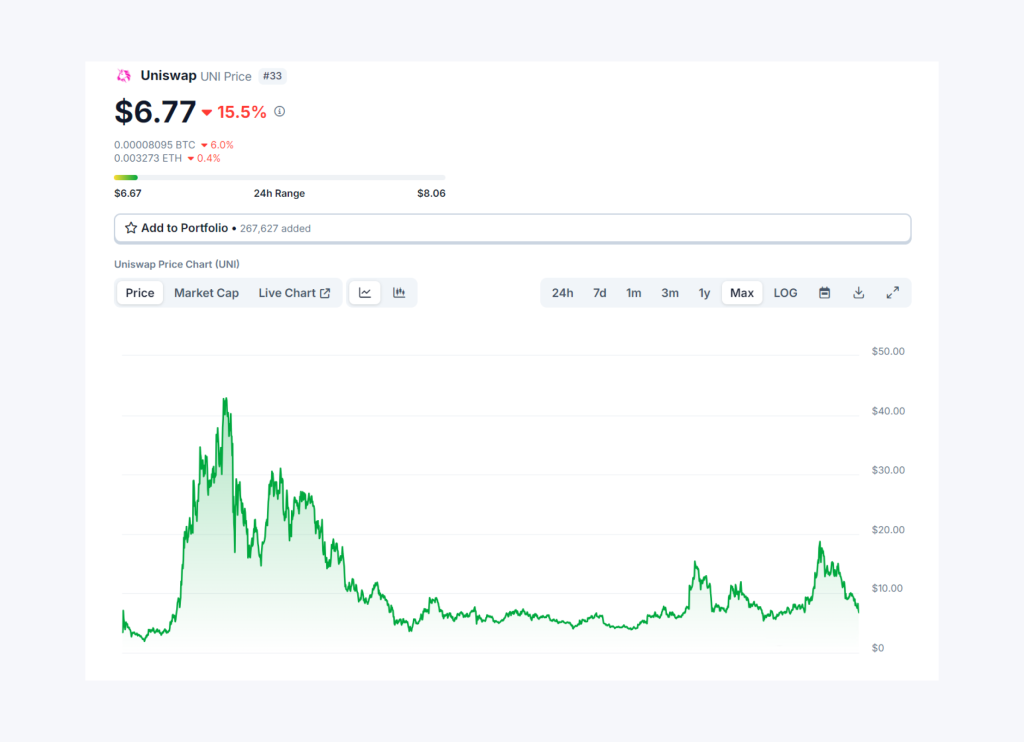
Fast Fact:
For businesses, partnering with a decentralized exchange development company can accelerate entry into this booming sector. Such firms typically offer end-to-end DEX development services, from conceptualization to deployment and ongoing maintenance.
Approaches to Decentralized Exchange Development
So, how do you actually build one? The road to launching a DEX isn’t one-size-fits-all—there are multiple approaches, each with its own trade-offs.
Building from Scratch
If you’re looking to break new ground in the DEX market, developing a platform from scratch is the ultimate way to build something unique. This means creating custom smart contracts, a bespoke user interface, and original trading mechanisms—all tailored to your vision.
Pros:
- Full customization—control every aspect of the platform, from UI/UX to liquidity models
- Unique branding—establish a distinct market presence
- Innovative feature integration—implement groundbreaking functionalities
Cons:
- High development costs—requires a team of experienced blockchain developers
- Longer time to market—custom platforms can take months or even years to fully launch
- Smart contract risks—new code needs extensive security audits to prevent exploits
For instance, dYdX started as a completely independent derivatives-focused DEX, developing its own off-chain order book and perpetual contract trading mechanism. Unlike simple swaps, its unique infrastructure has made it a standout name in DeFi.
White Label Crypto Exchange
For projects looking to enter the market quickly and cost-effectively, white-label solutions offer a ready-made exchange infrastructure with the option to tweak branding and some features. Instead of developing everything from scratch, you customize an existing platform.
Pros:
- Rapid deployment—get to market much faster
- Lower costs—no need for an in-house development team
- Pre-tested architecture—reduces technical bugs and vulnerabilities
Cons:
- Limited customization—restricted by the provider’s framework
- Third-party reliance—updates and security depend on an external team
- Less brand differentiation—platform may resemble others using the same template
Many corporate-backed DEXs leverage white-label solutions to integrate DeFi trading functionalities without major in-house development.
Forking an Existing Protocol
Forking means taking the open-source code of a successful protocol and modifying it to create a new platform. This method is fast, cost-efficient, and ensures compatibility with existing DeFi ecosystems.
Pros:
- Quick development—launch a functional DEX in a matter of weeks
- Established security—leverages a protocol that has been battle-tested
- Proven tokenomics—borrowing successful models reduces financial risk
Cons:
- Lack of originality—without significant innovation, the platform may struggle to attract users
- Inheriting vulnerabilities—any security issues in the original protocol carry over
- Market saturation—many projects are already using forked models
For example, SushiSwap began as a fork of Uniswap but differentiated itself by adding features like liquidity mining and governance rewards, proving that forks can be highly successful if they offer meaningful improvements.
Fast Fact:
Uniswap’s open-source model has been forked over 100 times by various projects.
How to Develop a DEX: A Step-by-Step Guide
Once you’ve chosen your development path, it’s time to dive into execution. A well-structured DEX requires strategic planning, robust smart contracts, and a seamless user experience.
- Define Your Goals and Requirements
Before writing a single line of code, establish a clear vision for your DEX. Ask yourself:
- Who is your target audience? (Retail traders, institutions, liquidity providers?)
- Will your DEX support multi-chain trading? (Ethereum, BNB Chain, Polygon, or all of the above?)
- How will you generate revenue? (Trading fees, staking rewards, token sales?)
A clear roadmap will help shape development priorities and market positioning.
- Choose the Right Blockchain
Your choice of blockchain will define transaction speed, fees, and scalability. While Ethereum remains the dominant player, its high gas fees have pushed many projects to alternative Layer 1 and Layer 2 solutions.
Popular blockchain options today:
- Ethereum (High security but expensive fees)
- BNB Chain (Lower fees, high-speed transactions)
- Polygon (Scalability and Ethereum compatibility)
- Solana (Lightning-fast transactions, but newer ecosystem)
For instance, PancakeSwap chose BNB Chain to avoid Ethereum’s high gas fees, making it a dominant player in low-cost DeFi trading.
- Develop Smart Contracts
Smart contracts are the core infrastructure of a DEX, governing trades, liquidity pools, and governance mechanisms. Engaging skilled blockchain developers or collaborating with a DEX development company guarantees secure and efficient coding.
Smart contract functions:
- Trade execution (AMM logic, order matching)
- Liquidity pool management (Token reserves, LP rewards)
- Fee collection (Trading fees, governance fees)
- Governance mechanisms (Voting, token staking)
Always undergo third-party audits before deploying smart contracts to avoid any types of exploits.
- Build an Intuitive User Interface
The success of your DEX depends on how easy it is for users to trade and interact. A clean, intuitive UI with seamless wallet integration is essential.
Key UI features will include:
- Wallet connectivity (MetaMask, WalletConnect)
- Real-time analytics (Charts, order books, transaction history)
- Mobile & desktop compatibility (Responsive design for all devices)
Today, traders prefer minimalist interfaces for their simplicity.
- Implement Security and Conduct Audits
Security is non-negotiable in decentralized finance. Hacks and smart contract exploits have led to billions in losses across the industry.
Essential security measures are:
- Smart contract audits (Hire reputable firms like CertiK, PeckShield, or OpenZeppelin)
- Bug bounty programs (Incentivize developers to report vulnerabilities)
- Penetration testing (Simulate attacks to test infrastructure resilience)
In 2023, a staggering 80% of all crypto exploits were linked to DeFi hacks. This highlights the crucial importance of having strong security protocols in place.
- Launch and Continuous Updates
After rigorous testing and audits, deploy the DEX on the mainnet and prepare for ongoing improvements. Successful platforms actively engage with their community to adapt, refine, and expand their ecosystems.
Post-launch priorities:
- Beta Testing (Soft launch with community feedback)
- Governance & Treasury Management (If issuing a governance token)
- Regular Updates (Fixing bugs, adding new features)
- Regulatory Monitoring (Adapting to legal frameworks)
Must-Have Features in a Modern DEX
The most successful platforms integrate cutting-edge features that enhance liquidity, streamline user experience, and drive engagement. Here’s what every modern DEX needs to stay ahead.
- Multi-Token Support
For a DEX to truly thrive, it must support a diverse range of assets. Although ERC-20 tokens lead the Ethereum ecosystem, the growth of multi-chain interoperability requires exchanges to support BEP-20 (BNB Chain), SPL (Solana), and other standards.
Take Uniswap, for example. Initially built around Ethereum’s ERC-20 standard, it has since expanded to Arbitrum, Optimism, and even BNB Chain, catering to a wider audience. Other platforms, such as PancakeSwap, have integrated NFT initiatives, bridging the gap between DeFi and digital collectibles.
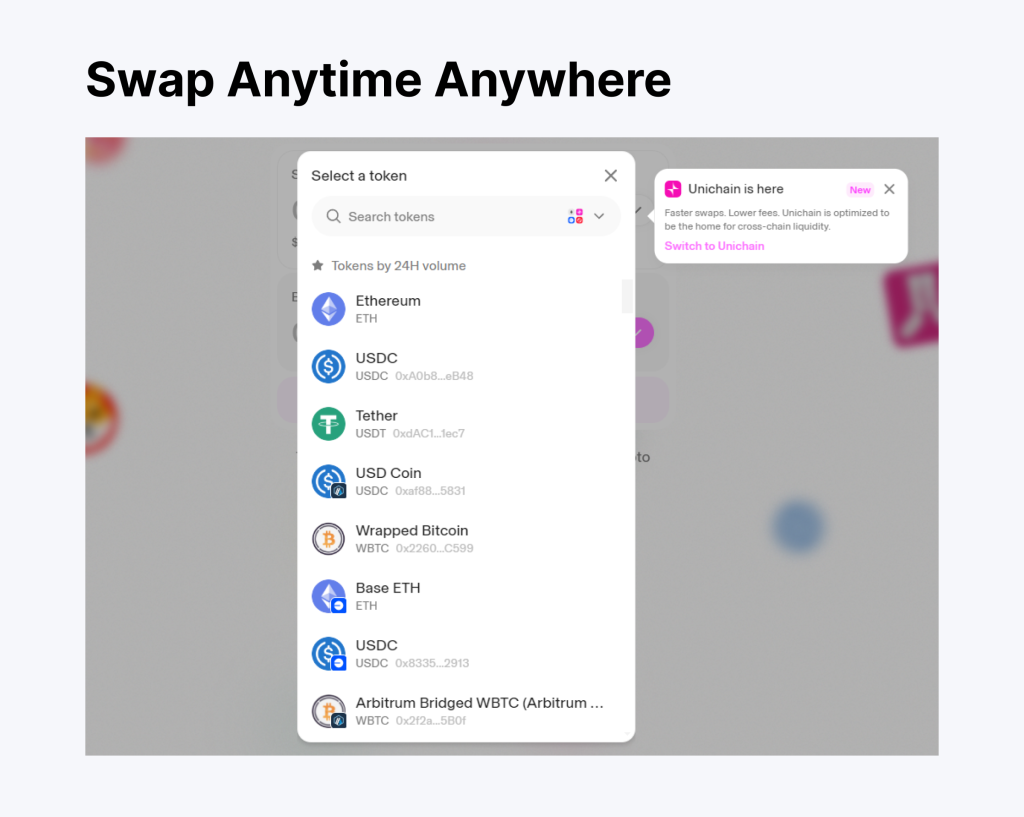
- Liquidity Mining
Liquidity is the backbone of any exchange. Unlike centralized platforms, which rely on market makers, DEXs leverage liquidity pools—funds provided by users who deposit assets into smart contracts. To incentivize participation, many DEXs offer liquidity mining rewards, distributing extra tokens to users who provide liquidity.
- Staking & Yield Farming
In DeFi, staking and yield farming go hand in hand with liquidity mining, offering users another way to earn passive income. Staking allows users to lock tokens in smart contracts to secure the network or gain governance rights, while yield farming enables traders to earn additional rewards on their assets.
Raydium, a leading Solana-based DEX, takes this a step further, offering dual-reward yield farming pools where users can earn multiple tokens simultaneously. Meanwhile, protocols like Curve Finance specialize in stablecoin staking, ensuring deep liquidity for pegged assets.
- Cross-Chain Swaps
As DeFi expands, traders increasingly demand cross-chain compatibility, allowing them to move assets between Ethereum, BNB Chain, Solana, Avalanche, and beyond—without relying on centralized bridges.
Platforms like Thorchain and Squid Router are already pioneering true cross-chain swaps, enabling seamless token transfers between blockchains without wrapping assets. Meanwhile, dYdX has introduced Layer 2 trading solutions to bypass Ethereum’s congestion.
- Advanced Trading Tools
For decentralized trading to compete with centralized venues, it must offer more than just simple swaps. Serious traders demand limit orders, stop-loss mechanisms, and analytics dashboards—features historically absent from AMM-based DEXs.
dYdX has set the standard here, integrating perpetual contracts, leverage trading, and order books while maintaining decentralization. Uniswap v3 introduced concentrated liquidity, allowing LPs to set custom price ranges for their deposits, mimicking traditional market-making strategies.
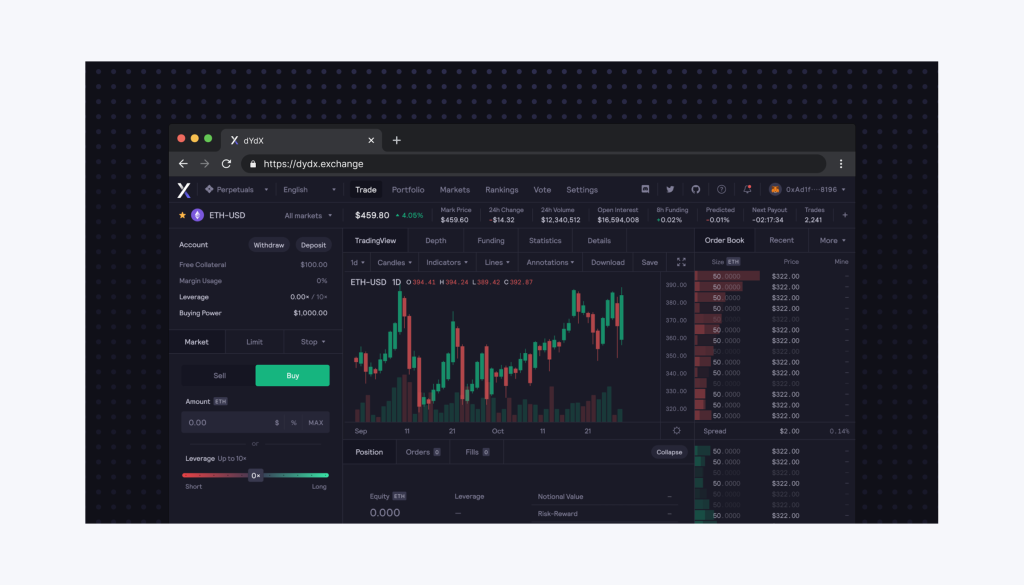
Monetization Strategies for Your Own DEX
Building a DEX is one thing, and making it profitable is another. Unlike centralized exchanges that generate revenue through withdrawal fees, margin lending, and custodial services, DEXs rely on decentralized models for monetization. However, that doesn’t mean there aren’t lucrative opportunities.
The key to a sustainable DEX is diversifying revenue streams while maintaining competitive fees and deep liquidity. Here’s how leading platforms are turning decentralized trading into a thriving business.
- Trading Fees
Every time a trade happens, the exchange takes a small cut. Most DEXs charge between 0.1% and 0.3% per transaction, with a portion of the fees often redistributed to liquidity providers.
- Uniswap takes a 0.3% swap fee, with the majority going to liquidity providers.
- dYdX, which specializes in perpetual contracts, charges dynamic trading fees based on volume tiers, similar to centralized exchanges.
High-volume trading means even small percentage-based fees can translate into millions in daily revenue.
- Governance Tokens
A governance token isn’t just about voting rights—it’s also a powerful monetization tool. By issuing tokens that provide platform incentives and governance rights, DEXs can generate revenue through token sales and staking models.
- SushiSwap introduced xSUSHI staking, allowing users to stake their SUSHI tokens and receive a portion of the platform’s fees.
- Curve Finance implemented a veCRV model, encouraging users to lock CRV tokens in exchange for boosted rewards and voting power.
Governance tokens create an engaged community, drive demand for native assets, and provide an alternative revenue stream beyond trading fees.
- NFT & Launchpad Services
DEXs aren’t just for token swaps anymore. NFT marketplaces, token launchpads, and IDOs (Initial DEX Offerings) provide additional ways to generate revenue.
- Binance DEX launched an NFT marketplace, combining tokenized art with decentralized trading.
- Polkastarter built a specialized launchpad for IDOs, offering a decentralized fundraising model that earns fees on new project launches.
New token and NFT launches attract fresh liquidity and trading activity, creating network effects that fuel long-term growth.
What to Look For in a Decentralized Exchange Development Company
The right development partner can accelerate your project’s launch, enhance security, and optimize performance, while the wrong choice could lead to vulnerabilities, poor execution, and wasted resources.
Here’s what to look for when evaluating a decentralized exchange software development company.
Technical Expertise
A high-performing DEX requires rock-solid smart contract architecture and deep blockchain integration. Your development partner should have proficiency in leading blockchain programming languages, including:
- Solidity (Ethereum and EVM-compatible chains)
- Rust (Solana and NEAR)
- Vyper (Ethereum smart contracts with enhanced security)
Expertise in Layer 2 solutions, cross-chain interoperability, and scalability frameworks like rollups (Optimistic, ZK-rollups) is also a major plus.
Security Track Record
Security is non-negotiable in DeFi. With billions locked in smart contracts, hacks, exploits, and vulnerabilities can lead to catastrophic losses. A proven security track record should be at the top of your checklist when selecting a decentralized exchange development services firm.
Key security credentials include:
- Smart contract audits
- Bug bounty programs (incentivizing ethical hackers to find vulnerabilities)
- Certifications (e.g., ISO 27001 for security management)
- Incident response plans (how they handle security breaches)
Client Portfolio: A Proven Track Record in DeFi
Would you hire an architect who has never built a skyscraper? The same logic applies to DEX development—your ideal partner should have a portfolio of successfully launched decentralized exchanges and DeFi protocols.
What to check:
- Past projects (Have they built AMM-based DEXs? Order book models? Hybrid solutions?)
- Blockchain diversity (Ethereum, Solana, BNB Chain, Avalanche, Polygon?)
- Liquidity management experience (Can they optimize liquidity pools and incentive structures?)
- Scalability solutions (Do they implement Layer 2 or cross-chain integrations?)
Post-Launch Support
A DEX isn’t a “set it and forget it” project. Even after launch, continuous updates, security patches, and feature rollouts are necessary to stay competitive. Ensure your white label crypto exchange software offers:
- Regular software updates (to improve efficiency and user experience)
- Ongoing security monitoring (to detect and patch vulnerabilities)
- Scalability upgrades (as trading volume increases)
- User support and troubleshooting (critical for adoption and retention)
Many early DeFi projects failed not due to bad ideas, but lack of long-term maintenance. Your DEX needs active development and adaptation to survive in a fast-moving industry.
Conclusion
Building a DEX requires technical expertise, strategic planning, and a strong focus on security. Whether you’re building a custom solution, modifying existing protocols, or leveraging white-label crypto exchange technology, success lies in innovation, community engagement, and long-term scalability.
As DeFi reshapes the financial world, those who develop robust, secure, and user-friendly DEX solutions will be at the forefront of this decentralized revolution.
FAQs
How does DEX make money?
DEXs generate revenue through transaction fees, LP fees, token listing fees, and premium features like advanced trading tools. Some DEXs also introduce native tokens that allow users to participate in governance and earn rewards.
How do I create a DeFi exchange?
Building a DeFi exchange involves several steps, including developing a smart contract, managing liquidity, designing a user interface, and conducting security audits.
What are the main challenges of developing a DEX?
Some major challenges include ensuring liquidity, maintaining security, complying with regulations, and achieving scalability. Developers must also address smart contract vulnerabilities and front-running attacks.
How do liquidity pools work in a DEX?
Liquidity pools are smart contract-based reserves of token pairs provided by users. Traders swap assets from these pools instead of a traditional order book. Liquidity providers earn fees from trades, incentivizing them to contribute to the pool and ensuring trading without relying on centralized market makers.
